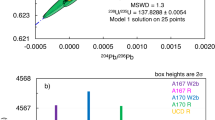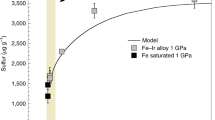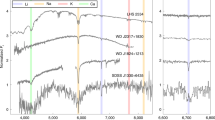Abstract
Recent technical advances have made it possible to measure the abundance of boron in ultramafic xenoliths from alkali basalts thought to be representative of the upper mantle. Such data can provide information on the cosmochemistry of boron, particularly the temperature and mode of condensation of this element from the solar nebula. Analysis of xenoliths, selected by Jagoutz et al.1 to represent fertile unaltered mantle, shows that the mean boron abundance is more than three times that expected for the condensation temperature of 700 K calculated by Cameron et al.2. Our measurements, reported here, suggest that boron condensed at approximately 1,200 K as a solid solution in alkali feldspar or anorthite and not as an independent phase.
This is a preview of subscription content, access via your institution
Access options
Subscribe to this journal
Receive 51 print issues and online access
$199.00 per year
only $3.90 per issue
Buy this article
- Purchase on Springer Link
- Instant access to full article PDF
Prices may be subject to local taxes which are calculated during checkout
Similar content being viewed by others
References
Jagoutz, E. et al. Proc. Lunar planet. Sci. Conf. 10, 2031–2050 (1979).
Cameron, A. G. W., Colgate, S. A. & Grossman, L. Nature 243, 204–207 (1973).
Higgins, M. D. et al. Proc. Int. Symp. on Use and Development of Low and Medium Flux Research Reactors (Massachusetts Institute of Technology, in the press).
Gladney, E. S., Jurney, E. T. & Curtis, D. B. Analyt. Chem. 48, 2139–2142 (1976).
Bergeron, M., Buffet, G., Higgins, M. D. & Shaw, D. M. Geol. Ass. Canada Progm 8, A6 (1983).
Higgins, M. D. & Shaw, D. M. Geol. Ass. Canada Progm 8, A32 (1983).
Curtis, D., Gladney, E. & Jurney, E. Geochim. cosmochim. Acta 44, 1945–1953 (1980).
Anders, E. & Ebihara, M. Geochim. cosmochim. Acta 46, 2263–2380 (1982).
Kohl, J. L., Parkinson, W. H. & Withbroe, G. L. Astrophys. J. Lett. 212, L101–L104 (1977).
Wai, C. M. & Wasson, J. T. Earth planet Sci. Lett. 36, 1–13 (1977).
Grossman, L. & Larimer, J. W. Rev. Geophys. Space Phys. 12, 71–102 (1974).
Smith, J. V. Feldspar Mineralogy Vol. 2 (Springer, Berlin, 1974).
Failey, M. P. thesis, Univ. Maryland (1979).
Higgins, M. D. Geostandards News (in the press).
Author information
Authors and Affiliations
Rights and permissions
About this article
Cite this article
Higgins, M., Shaw, D. Boron cosmochemistry interpreted from abundances in mantle xenoliths. Nature 308, 172–173 (1984). https://doi.org/10.1038/308172a0
Received:
Accepted:
Issue Date:
DOI: https://doi.org/10.1038/308172a0
This article is cited by
Comments
By submitting a comment you agree to abide by our Terms and Community Guidelines. If you find something abusive or that does not comply with our terms or guidelines please flag it as inappropriate.



